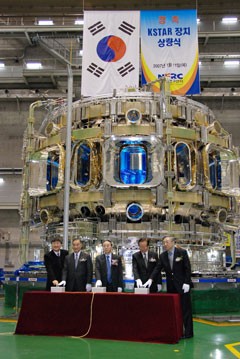ITER NEWSLINE
6
Cryostat of Korean fusion experiment KSTAR installed
-
Cryostat of Korean fusion experiment KSTAR installed

The KSTAR cryostat closure ceremony. From left to right: Lee Gyung-Su, Vice- President of NFRC, Chung Kun Mo, Former minister, Ministry of Science and Technology (MST), Kim Woo-Sik, Vice Prime-Minister of MST, Chae Yung bog, Former minister of MST, and Shin Jae-In, President of NFRC.
The goal of the Korean fusion programme is to contribute to the development of fusion energy by providing useful technical information, via KSTAR, to the ITER programme and to join in the future foreseen development path for future fusion power plants.
NFRC expects that due to its long-pulse D-shaped plasma characteristics and modest operation cost, KSTAR can serve as a useful pilot experimental device prior to ITER operation. Its expected 4 to 5 years of high power long-pulse operation before ITER comes online can provide useful technical knowledge and data for ITER operation.
The South Korean government plans to produce a long-term plan this year focused on nuclear fusion energy. More information can be found on the KSTAR website.
return to Newsline #6


